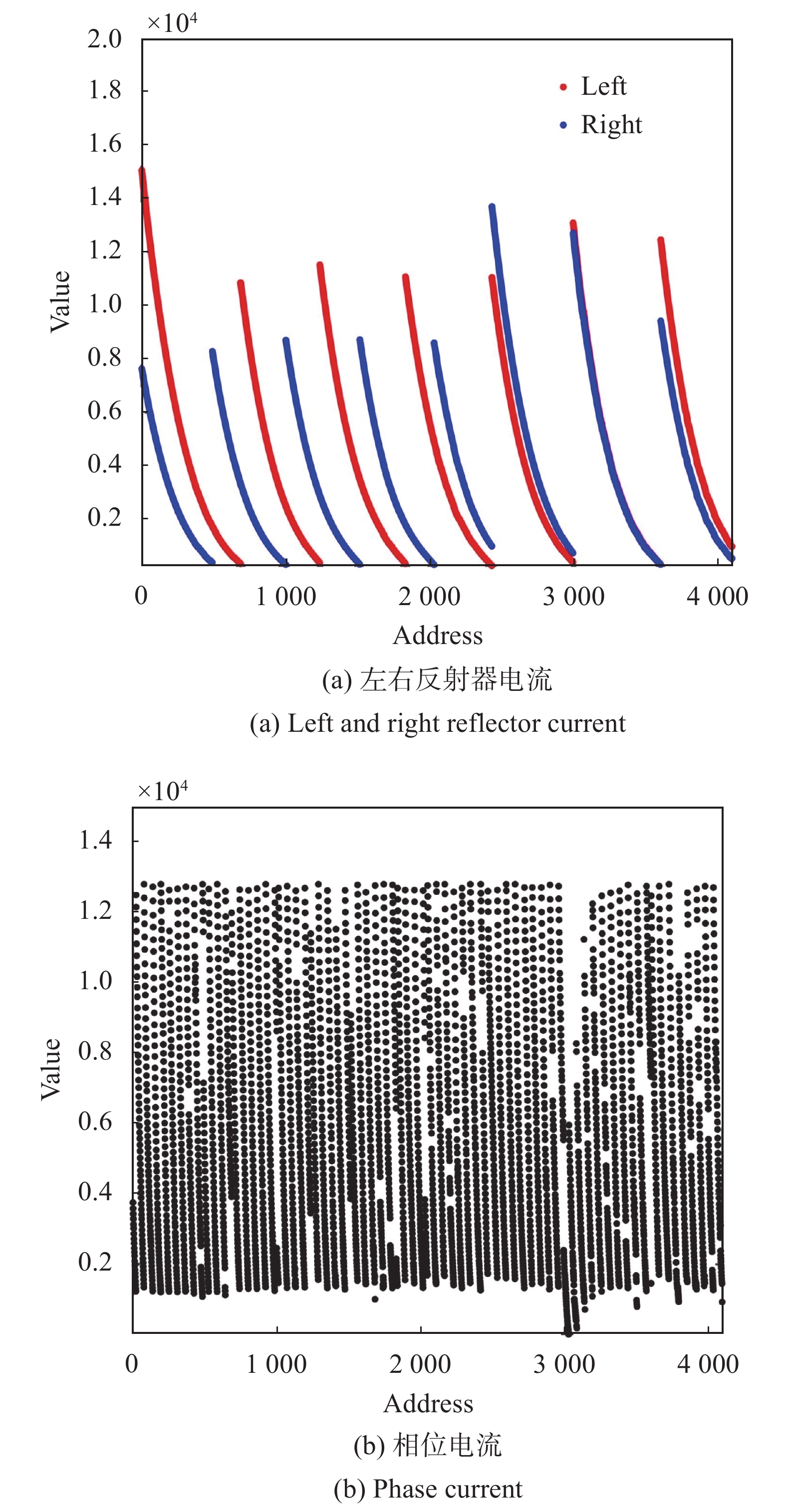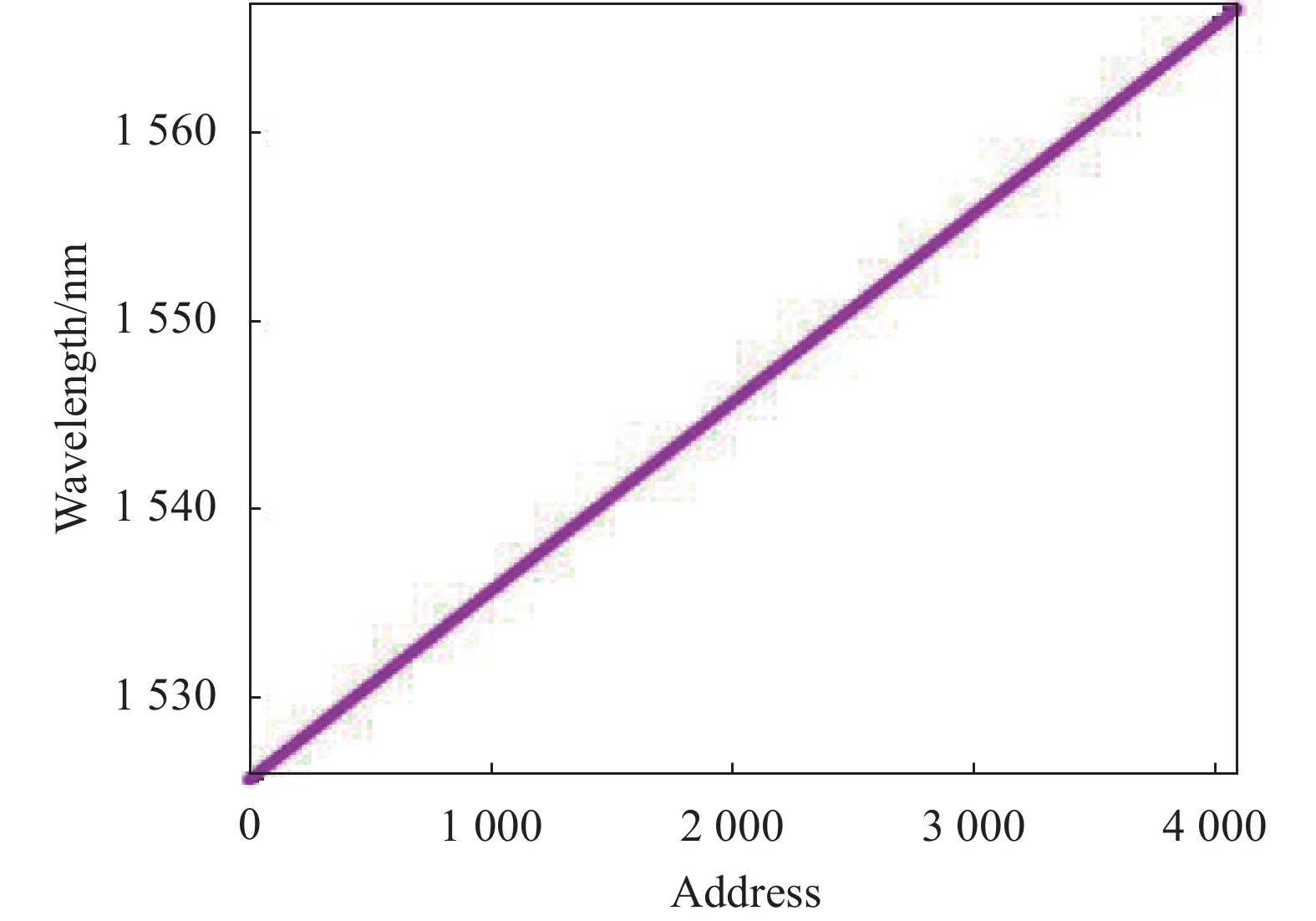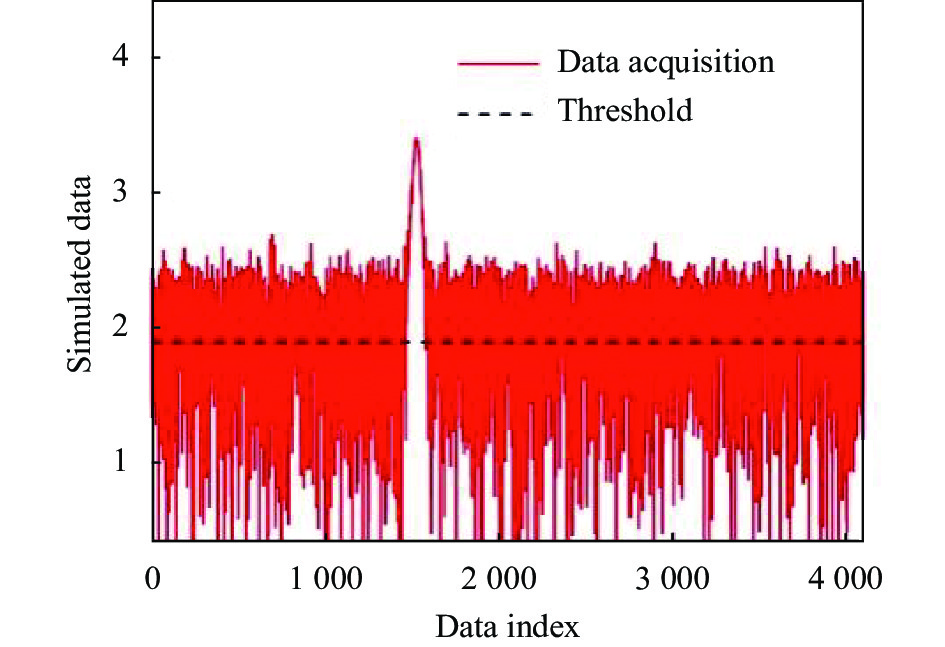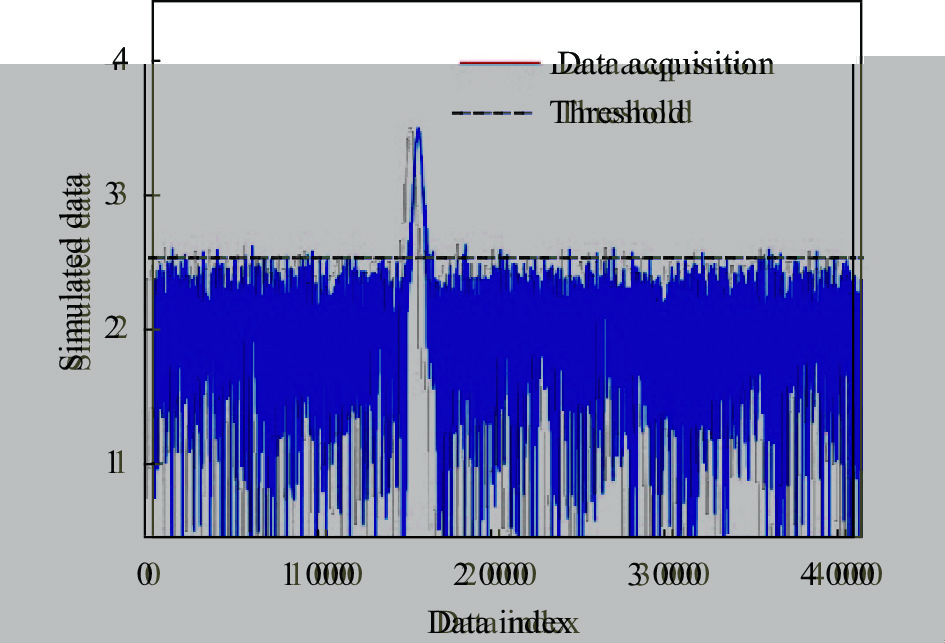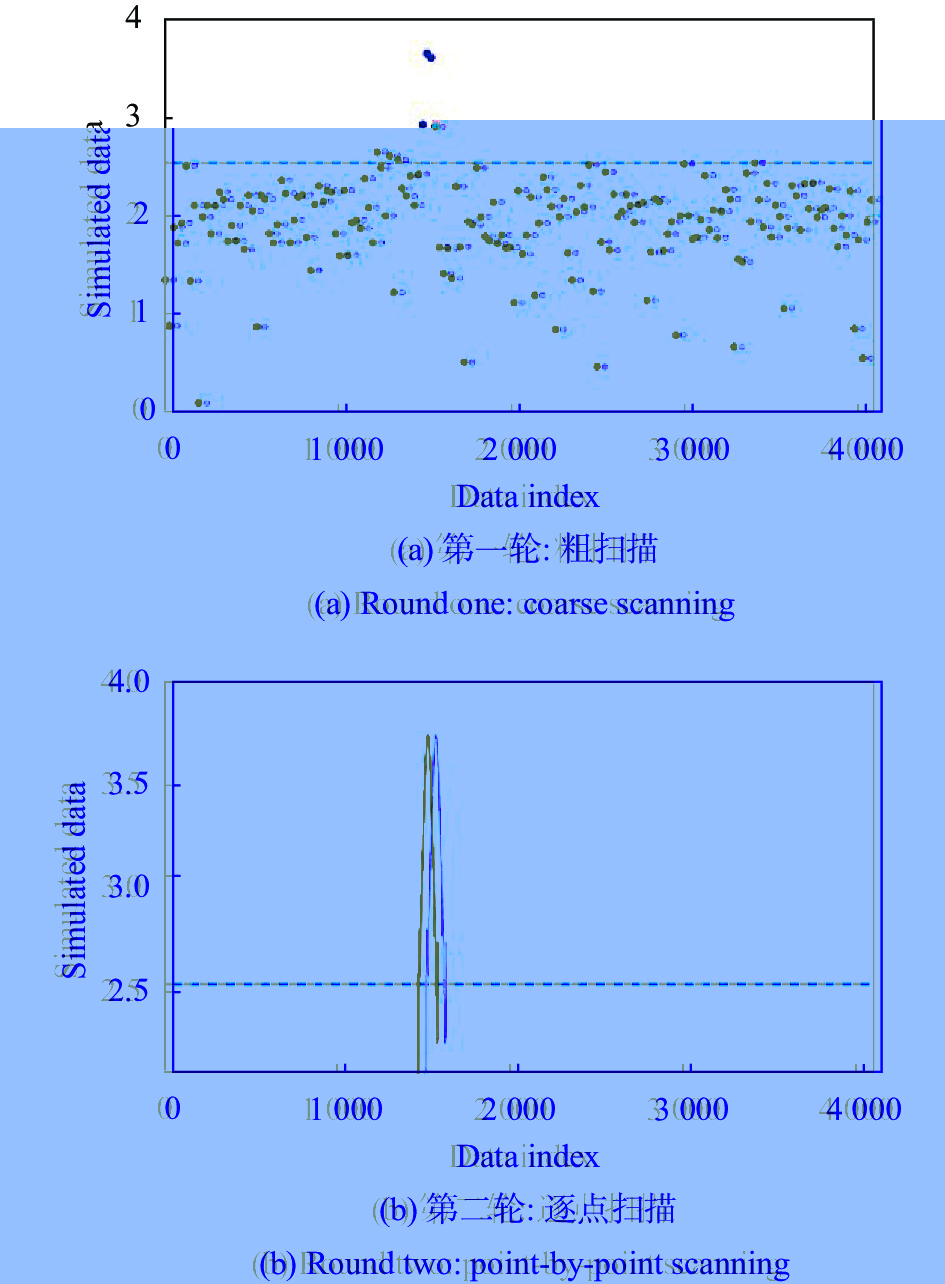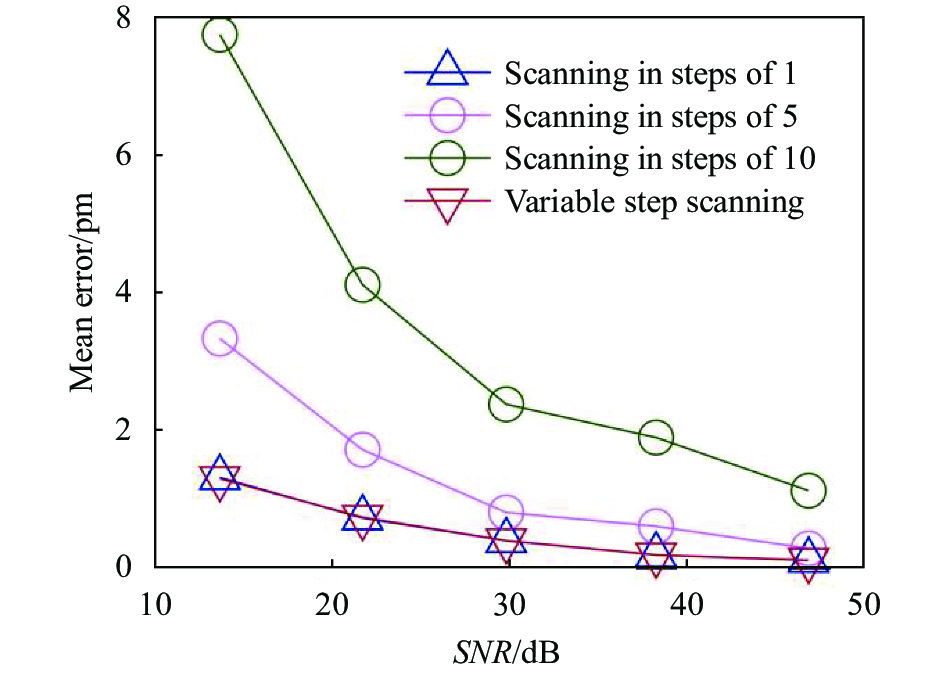-
与传统的电传感器相比,光纤传感器以光为载体传递信息,具有耐腐蚀、耐高温、抗电磁干扰等优点,可实时测量温度、应变、加速度等多种物理量,被广泛应用于航空航天、生物医疗、石油勘探等[1−6]领域。
目前,在温度、应力监测等静态测量领域,光纤光栅解调仪器已经得到了普遍应用,而在振动、冲击等高速动态信号测量领域,高速光纤布拉格光栅(FBG)解调系统的研发仍然有很高的实用价值[7]。李佳等[8]采用线阵电荷耦合器件(CCD)光谱成像法高速采集光纤光栅在时域上的256个像素点对应的光强,通过高斯拟合得到光纤布拉格光栅反射光谱,实现最高35 kHz的光谱采样速率,以降低分辨率水平为代价提高测量速度。乔学光等[9]采用光纤超荧光光源的线性边带作为边沿滤波器,以边沿滤波法实现了200 kHz的解调频率,但解调性能会受光源稳定性影响。Ding[10]提出了一种基于低损耗干扰阵列宽带锯齿(JAWS)滤波器的快速解调系统,采用双边缘滤波法解调,解调速度达到200 kHz,但受限于滤波器的特性,只能询问小波长范围内的FBG,通用性不强。
相比之下,扫描激光器法具有光信号功率大、信噪比高、可测通道数目多、成本相对较低的优势[11],但其采用固定步长逐点扫描的方式,一次扫描过程采集数千个信号点,需要花费大量时间获取光谱数据,限制了解调速度。郭峻[12]通过改进数字超模分布式布拉格反射激光器(DS-DBR)的驱动电路,使激光器扫描频率达到1 MHz,通过提高激光器的波长切换速度提高解调速度。Yang等[13]提出了一种基于布内曼频率估计的FBG快速波长解调算法,只需获得FBG包络中4个采样点,适用于低分辨率的CCD光谱仪或可调谐激光器解调系统,通过减少获取的采样点数提高解调速度,但是精度不高。
针对扫描激光器型光纤布拉格光栅波长解调仪在实际应用中调谐次数多、扫描耗时久的问题,文中设计了一种变步长的激光器扫描策略,使用较少的波长调谐次数实现光谱局部峰值的检出,减少了扫描时间和待传输的数据量,从而降低了数据传输压力和软件的时空复杂度,提高了解调速度,且不影响后续中心波长的计算。
-
为了增加高效扫描策略的通用性,解调系统启动后需要先通过一次逐点扫描获取最高分辨率的光谱,再以根据光谱确定粗扫描时的扫描步长与阈值。
在一轮扫描过程中,采集点的数量直接取决于扫描范围和扫描步长。则需要采集的点数满足:
式中:${N_q}$为需要采集的点数;q为光谱最小调谐步长;${\lambda _{{\text{max}}}}$为扫描的光谱波长最大值;${\lambda _{{\text{min}}}}$为扫描的光谱波长最小值。
由于文中的高效扫描策略的关键之一是初始化时设定的阈值,FBG反射谱中带有一定功率的加性噪声,影响后续阈值确定算法的准确性,因此在计算阈值前,需要先采用滑动平均滤波器对逐点扫描得到的模数转换器(ADC)数据进行平滑处理:
滤波后的数据由最大类间方差法(OTSU)计算阈值。OTSU是一种自适应的阈值确定算法,常用于实时图像分割领域,基本思想是根据图像的灰度特性,将图像分成目标和背景两个部分,目标和背景之间的类间方差越大,说明分割的效果越好[14]。
将OTSU算法引入光谱波峰分割中,采样数据被阈值分割为目标波峰区域A和背景噪声区域B,区域A和区域B出现的概率分别为:
式中:${\omega _A}$为区域A出现的概率;${\omega _B}$为区域B出现的概率;${N_A}$为区域A内的采样点数;${N_B}$为区域B内的采样点数;$\left[ {0,L - 1} \right]$为ADC采样值范围; N为波长扫描范围内的可采样点数;t为阈值;${n_i}$是采样值为$i$的采样点数。
区域内采样点均值分别为${\mu _A}$和${\mu _B}$:
式中: ${Y_A}$和${Y_B}$分别为区域A和B内采样点的总采样值。
区域A与B之间的类间方差${\tau ^2}$为:
由于总采样点数N是固定的,省略该项不影响最大类间方差的选取,此处可对其进行省略以便于计算,即简化的类间方差${\delta ^2}$为:
当类间方差最大时,目标和背景的分割差错概率最小,因此选取此时的阈值$t$为最终的阈值。
阈值选取完成后,按顺序读取滤波后的ADC数据与解调仪设定的阈值作比较,以采样点${y_i}$($i \in \mathbb{R}|0 \leqslant i \leqslant N - 1$)中大于阈值的采样点作为有效数据点,以连续的有效数据点作为一个波峰,在系统内部设计了寄存器,保存各波峰的开始索引a和结束索引b($a,b \in i$),并计算位置之差$\Delta i = b - a + 1$作为峰宽。若存在峰宽$\Delta i < 5$的波峰,视为噪声造成的假峰舍弃。
为了在变步长扫描阶段能去除大于阈值的假峰,需要保证波峰范围内至少有3个粗扫描采样点大于阈值,因此当有多个波峰存在时,粗扫描步长为:
式中:p为粗扫描步长;$\Delta {i_{{\text{min}}}}$为波峰峰宽中的最小值。
则第一轮粗扫描的采样点数为:
式中:${N_1}$为第一轮粗扫描的采样点数;p为粗扫描步长;$N$为逐点扫描模式的总采样点数。
-
变步长扫描策略的实现主要由粗扫描、阈值比较、范围选取、局部逐点扫描4个阶段组成,如图1所示。
在粗扫描阶段,现场可编程门阵列(FPGA)读取存储的“地址-码字”查找表,采样地址以p为步长增加,使激光器输出波长按照所设置的扫描间隔稳定输出,直到下一个采样地址超出地址空间即为粗扫描结束。粗扫描得到采样数据${y_j}$($j \in \mathbb{R}|0 \leqslant j \leqslant {N_1} - 1$),若${y_j} \geqslant t$,将采样数据${y_j}$与索引j分别存入寄存器中。
其中,采样地址与粗扫描采样点的索引之间存在关系如下:
式中:$i$为采样地址;j为粗扫描数据的索引。
由于粗扫描得到的采样点间隔大不适合进行滤波去噪,因此需要通过进一步判断以舍弃因受噪声影响使采样值大于阈值的点。对于大于阈值的采样点,若与其相邻的采样点均小于阈值,则视为噪声点舍弃,余下的连续点${y_c}$,${y_{c + 1}}...{y_d}$($c,d \in j$)则视为波峰范围内的粗扫描采样点。
由于第一轮粗扫描阶段扫描的数据索引不变,当光纤中心波长发生迁移时,落在波峰范围内的粗扫描采样点会在3或4个中变化,从而影响第二轮扫描的采样点数量。如图2所示,图2(a)为逐点扫描得到的一组采样数据,大于阈值的粗扫描采样点为3个;当波峰向右迁移0.09 nm时,大于阈值的粗扫描采样点仍为3个;当波峰向左迁移0.05 nm时,大于阈值的粗扫描采样点变为4个。
针对第二轮扫描的点数可能不固定的问题,统一以大于阈值的粗扫描采样点的最大可能值为标准,即以$e = c + 3$为修正后的波峰范围内的粗扫描采样点索引的最大值。
根据公式(11),对于修正后的波峰范围内的粗扫描采样点${y_j}\left( {j \in \mathbb{R}|c \leqslant j \leqslant e} \right)$,其采样地址范围为$\left[ {p \times c,p \times e} \right]$。为了确保后续逐点扫描时能采到所有大于阈值的采样点,实际选取二次扫描范围时以波峰范围内的粗扫描采样点范围分别向左和右扩展1个粗扫描采样点,即第二轮的逐点扫描选定采样地址范围$\left[ {p \times (c - 1),p \times \left( {e + 1} \right)} \right]$。则第二轮逐点扫描的采样点数为:
FPGA依据二次扫描范围的起始地址${d_1} = p \times (c - 1)$和结束地址${d_2} = p \times (e + 1)$读取存储的“地址-码字”查找表,采样地址以1为步长增加。起始地址${d_1}$、结束地址${d_2}$与扫描得到的采样数据${y_i}$($i \in \mathbb{R}|{d_1} \leqslant i \leqslant {d_2}$)序列共同封装为数据包传输至上位机。
由公式(10)和(12)可知,在一轮解调过程中进行了两轮扫描,总采样点数为:
其中需要发送给上位机进行寻峰处理的只有${N_2}$个采样数据。
由于激光器每扫描一个点需要的时间是固定的,更少的采样点意味着更低的扫描时间,由于解调所需时间包括扫描时间,因此更少的点也意味着更高的解调速度。
-
文中提出并设计了一种基于调制光栅Y分支型(MG-Y)激光器的FBG波长解调系统,如图3所示,该系统由ATLS7500型分布式布拉格反射(DBR)激光器、FPGA、高精度模数转换器、高精度数模转换器(DAC)、光电探测器、对数跨阻放大器和温控模块组成。
温控模块使激光器工作在恒定温度,FPGA中设计的数字系统根据需要扫描的波长控制DAC输出高精度电流,从而使可调谐激光器发出波长稳定的激光,入射光经FBG阵列反射后通过环形器、光电探测器和对数跨阻放大器转换为电压信号,由ADC进行模数转换后输入FPGA进行处理,二次逐点扫描得到的光谱数据会由FPGA发送至上位机进行解调。
-
扫描策略实现的关键之一在于可调谐半导体扫描光源的精确控制[15],标定时需要精确测量给定控制电流下的激光器输出波长。MG-Y激光器正常工作需要5路电流输入,其中需要左、右光栅区和相位区这三个调谐区电流同时调谐以改变输出激光的波长。为了使输出激光的波长能稳定在扫描策略所需要的波长上,以适用于光纤传感应用的MG-Y型激光器快速自动化测试技术[16],构建了覆盖1 525.9~1 566.85 nm、光谱扫描步长${R_q} = 0.01$nm的“波长-电流”查找表。其中,波长扫描范围内的可采样点数${R_N} = $4096。
将“波长-电流”查找表转换为“地址-码字”查找表存入随机存取存储器(ROM)中,如图4所示。FPGA按地址读取ROM中的码字写进DAC对应的寄存器中,DAC输出调谐电流控制激光器输出对应地址的波长。
激光器输出波长满足公式(14),如图5所示。
式中:$\lambda $为激光器输出波长;$q = 0.01$为激光器最小调谐步长;$i$($i \in \left[ {0,409\;5} \right]$)为波长对应的采样地址;${\lambda _0} = 1\;525.9$为采样地址$i = 0$处对应的激光器输出波长。
后续解调过程中可直接对采样地址进行计算得到光纤中心波长对应的采样地址值,再根据采样地址与激光器输出波长的关系求得中心波长。
-
FPGA以最小扫描步长进行全局扫描,对扫描得到的光谱数据平滑滤波后截取大于阈值的采样值进行高斯拟合寻峰,得到的高斯拟合函数的期望地址值近似为1 521.07,代入公式(14)可得到中心波长为1 541.111 nm。
为了测试文中的变步长扫描策略受信噪比(SNR)的影响,选取与拟合得到的高斯函数具有相同3 dB带宽和期望、幅值不同的高斯函数${Y_{\text{g}}}$作为无噪声时的光谱信号,由于解调仪得到的光谱经过对数互阻放大器的作用,可以推出无噪声的原始光谱信号近似${Y_{\text{s}}} = \exp \left( {{Y_{\text{g}}}} \right)$。叠加噪声后再取对数得到解调仪逐点扫描采集的数据的仿真值。通过调整噪声功率,可在不同信噪比的情况下测试变步长扫描策略的适用性。
数字信号x(n)的功率计算公式为:
式中:P为序列x(n)的功率;${N_x}$是序列x(n)的长度。
信噪比计算公式为:
式中:SNR是信噪比;${P_{\text{s}}}$是信号的功率;${P_{\text{n}}}$是噪声的功率。
当信噪比为7.87 dB时,如图6所示,初始化时通过OTSU得到的阈值没能合理地分割波峰与无用信号,此时不再适用文中的变步长扫描策略。
当信噪比为9.23 dB时,如图7所示,初始化得到阈值${R_{\text{t}}} = 2.54$能合理分割波峰与无用信号,粗扫描步长${R_{\text{p}}} = 24$。
根据阈值${R_{\text{t}}} = 2.54$和粗扫描步长${R_{\text{p}}} = 24$使用变步长扫描策略,如图8所示。第二轮扫描中准确获取了光谱中波峰处的数据。图8(a)中粗扫描采样点171个,图8(b)中逐点扫描采样点121个,相对于固定步长逐点扫描方式所需的4 096个采样点减少了92.9%。
-
在信噪比13.65~50.87 dB范围内等间隔选取5种信噪比情况,使用固定步长分别为1、5、10的扫描方式和变步长扫描策略各进行100组仿真测试,并对每组测试得到的采样数据平滑滤波后进行高斯拟合寻峰得到测量峰值,以原始信号${Y_{\text{g}}}$的期望值作为理论峰值,得到理论峰值与测量峰值的误差值。计算各信噪比下使用固定步长扫描方式和变步长扫描策略的采样数据解调的平均寻峰误差,如图9所示。

Figure 9. The average peak-seeking error of scanning with different fixed step sizes and the variable step scanning strategy at different SNR
由图9可知,随着信噪比的提升,四种解调方式的平均误差均有所下降。其中,在信噪比相同的情况下,固定步长为1的扫描方式和变步长扫描方式的平均寻峰误差基本相同,且扫描时固定步长越大,寻峰的平均误差越大。
选取${SNR} = 13.65\;{\text{dB}}$和${SNR} = 38.25\;{\text{dB}}$情况下得到的四种扫描方式的寻峰误差,绘制概率分布直方图和正态分布拟合图,如图10~11所示。

Figure 10. Histogram and normal distribution fitting plot of the probability distribution of peak-seeking error under the four scanning modes when ${SNR} = 13.65$ dB

Figure 11. Histogram and normal distribution fitting plot of the probability distribution of peak-seeking error under the four scanning modes when ${SNR} = 38.25$ dB
图10~11中$\mu $和$\sigma $分别为正态分布拟合图的期望和标准差,根据3σ原则,可以认为区间$\left( {\mu - 3\sigma ,\mu + 3\sigma } \right)$为误差值实际可能的取值区间。在50 MHz的时钟频率下,选取扫描范围1 525.9 ~1 566.85 nm ,激光器的1个单位步长为0.01 nm,每隔3个时钟周期切换一次输出波长,变步长扫描策略的两种扫描模式之间的逻辑判断额外耗费5个时钟周期,则根据图10~11可以推算出四种扫描方式在两组信噪比下采样数据的解调性能,如表1所示。
SNR/dB Scanning mode Maximum peak seeking error/pm Scanning points Scanning time/μs 13.65 Scanning in steps of 1 4.913 4 4 096 245.76 Scanning in steps of 5 12.378 3 820 49.2 Scanning in steps of 10 29.152 7 410 24.6 Variable step scanning 4.880 4 289 17.44 38.25 Scanning in steps of 1 0.747 4 096 245.76 Scanning in steps of 5 2.365 5 820 49.2 Scanning in steps of 10 7.430 9 410 24.6 Variable step scanning 0.747 258 15.58 Table 1. Demodulation performance of sampled data from four scanning methods with different SNR
由表1可知,使用变步长扫描策略与固定步长为1的扫描方式获取的采样数据的解调精度相近,且随着信噪比增加趋于相同。其中,由于不同信噪比下选取的阈值和粗扫描步长不同,变步长扫描方式的采样点数不同,但在阈值和粗扫描步长已确定的情况下后续扫描点数不会再发生改变,且扫描点数和扫描耗时均减少了至少90%。采用固定步长为10的扫描方式与变步长扫描方式的扫描耗时相近,但采样数据解调误差太大,实际应用价值不高。
此外,使用变步长扫描策略在实际应用中仅第二轮扫描的点需要传输,极大地减少了传输与后续解调消耗的资源。在不受后端解调算法处理速度制约的情况下,采用变步长扫描策略可以使解调速度提高至10倍。
-
文中设计了一种变步长扫描策略,该策略通过OTSU算法获得阈值和粗扫描步长,在一次解调过程中通过两轮扫描,能以更少的采样点数获取光谱波峰处的数据。在通道内只有单个光栅的情况下,与固定步长的扫描方式相比,采用变步长扫描方式的采样点数减少了至少90%,使扫描激光器型解调系统的解调速度提高至10倍。文中实验均基于单峰检测,单通道内多光纤光栅的情况下变步长扫描策略的采样点数与光栅数目会成倍数关系。仿真与解调实验的结果表明,在信噪比不低于9.23 dB的情况下,可以使用变步长扫描策略,且对后续解调的精度和准确性几乎没有影响,能够可靠地满足基于扫描激光器型解调系统的高速解调需求,具有很好的应用前景。
High speed demodulation of FBG based on variable step scanning strategy
doi: 10.3788/IRLA20230671
- Received Date: 2024-01-03
- Rev Recd Date: 2024-02-18
- Publish Date: 2024-04-25
-
Key words:
- fiber grating /
- high-speed demodulation /
- tunable laser /
- wavelength tuning
Abstract:






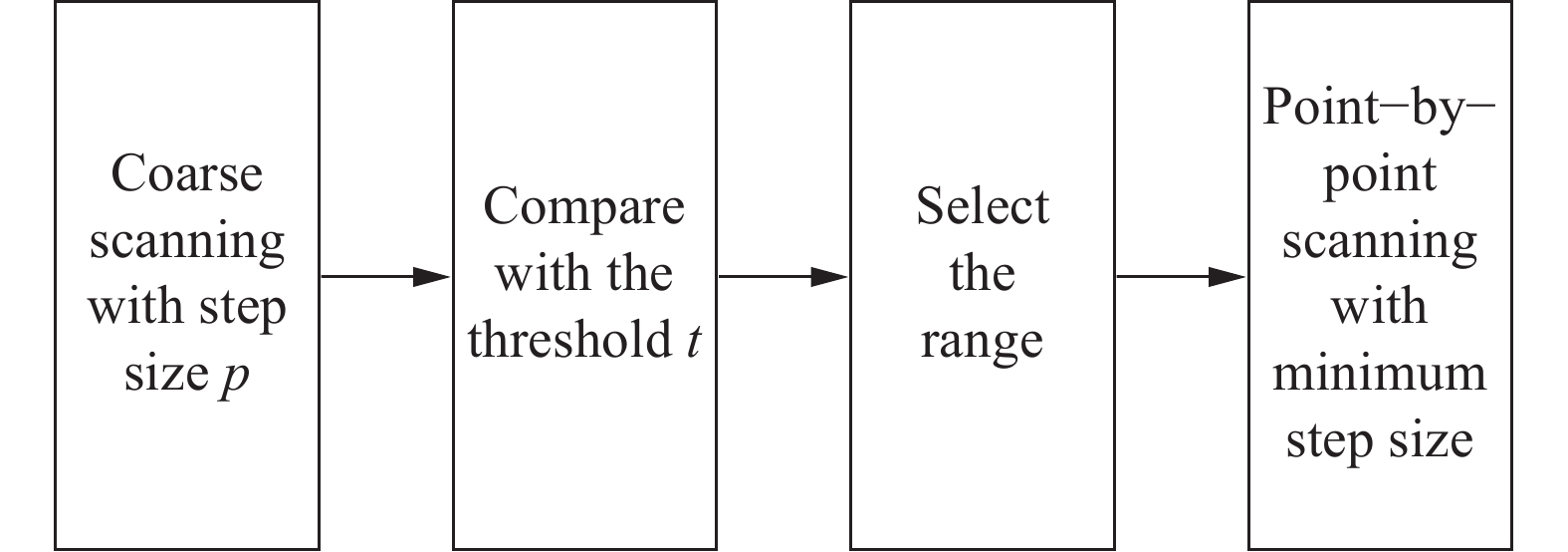



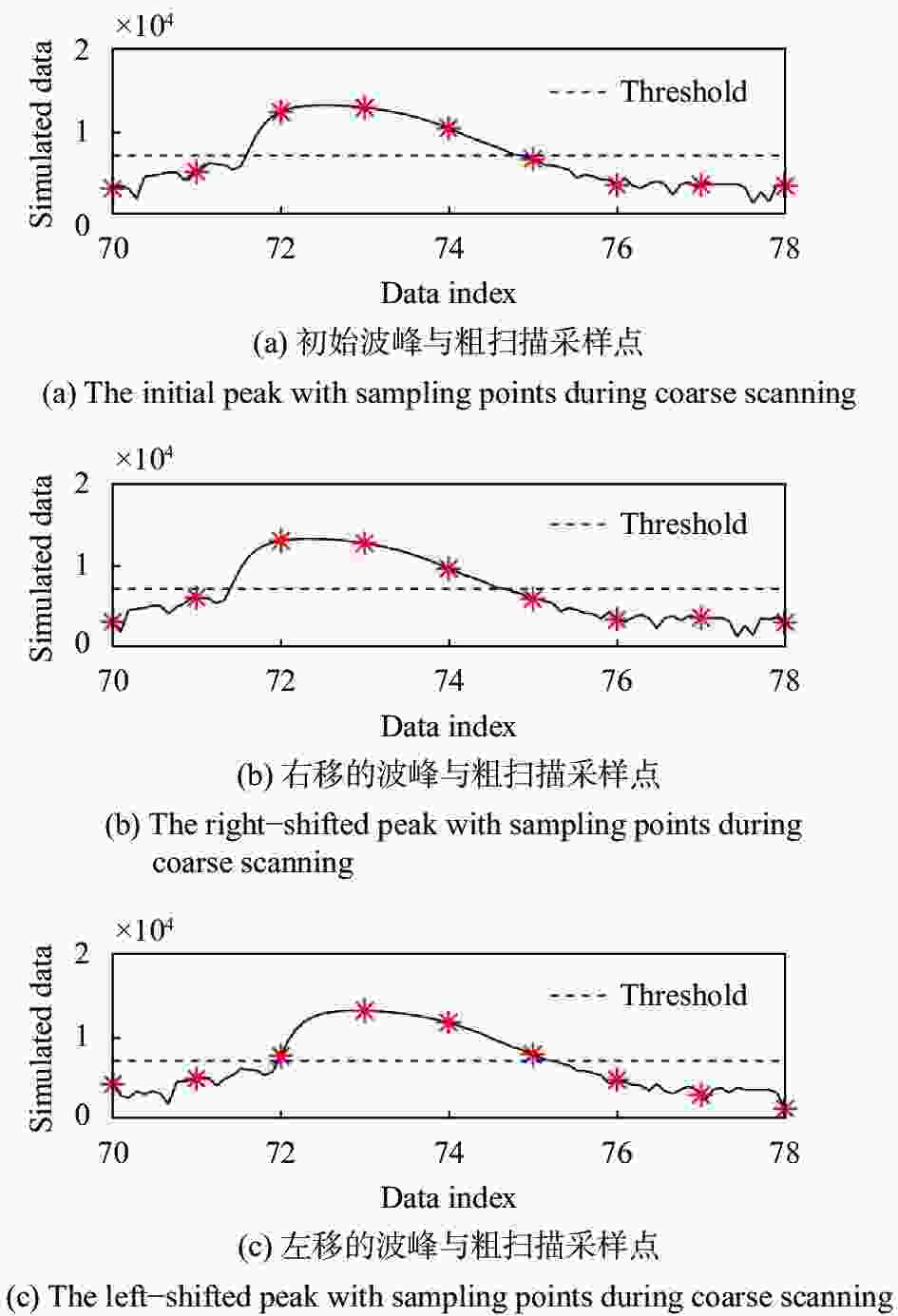

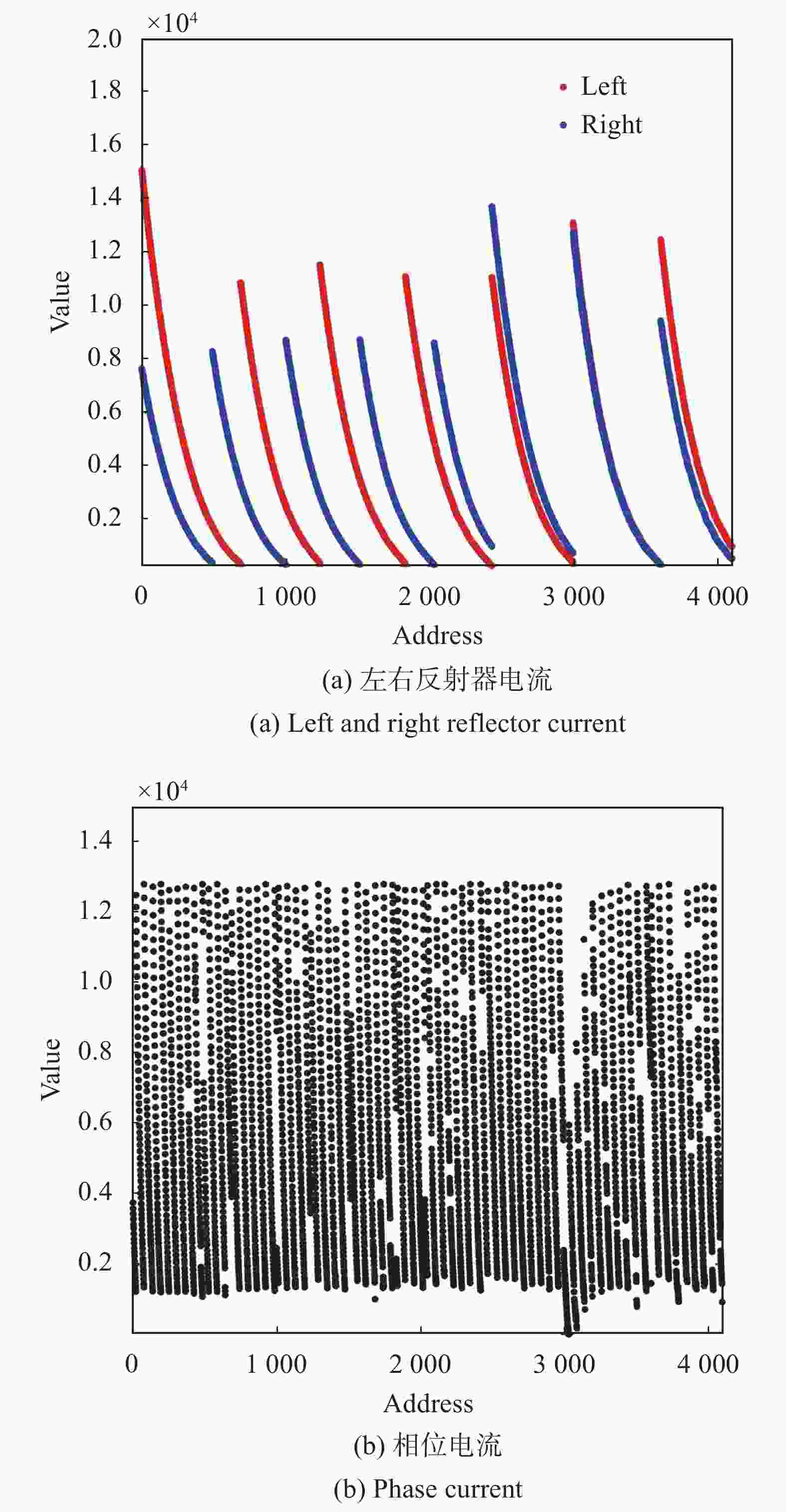
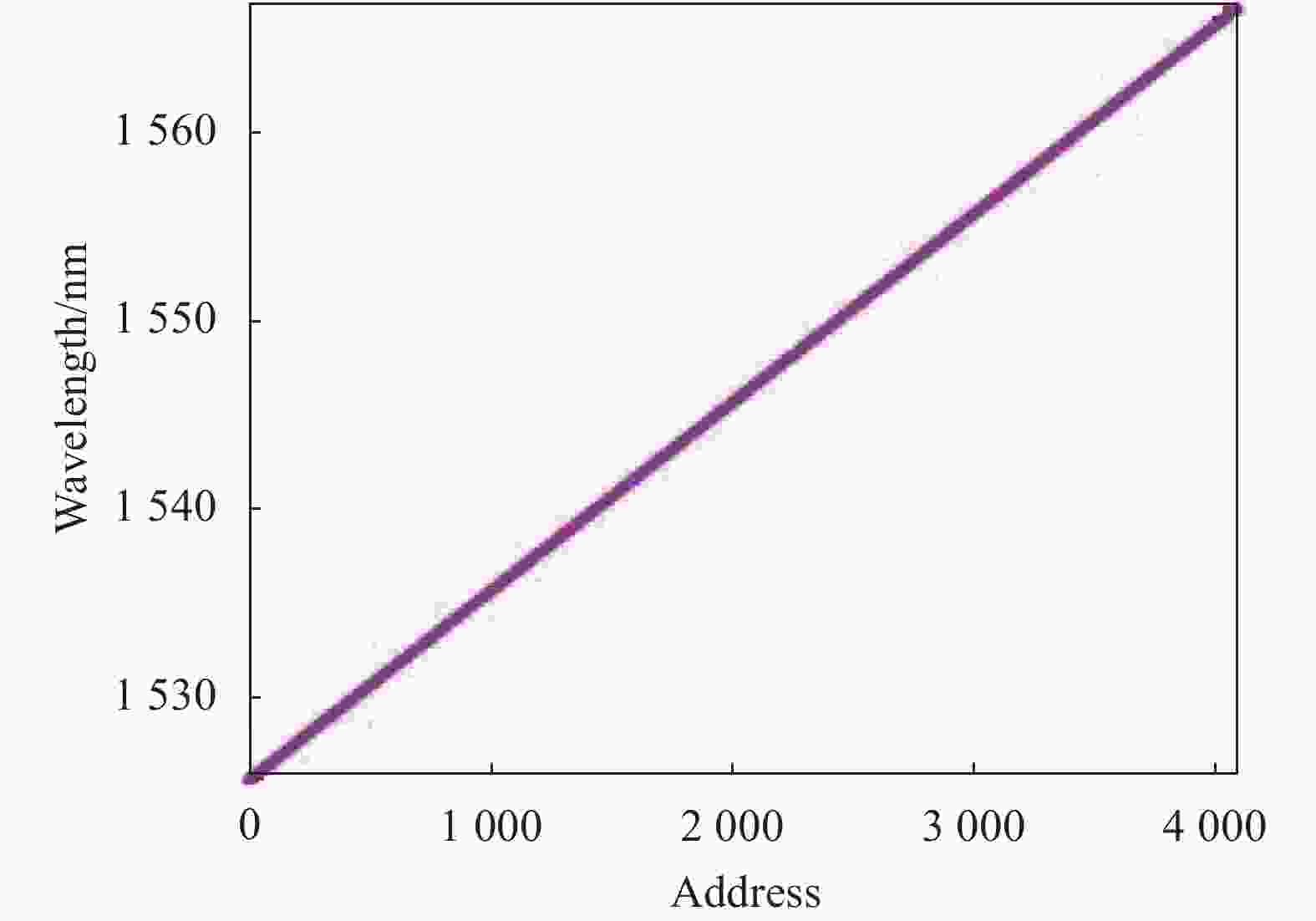
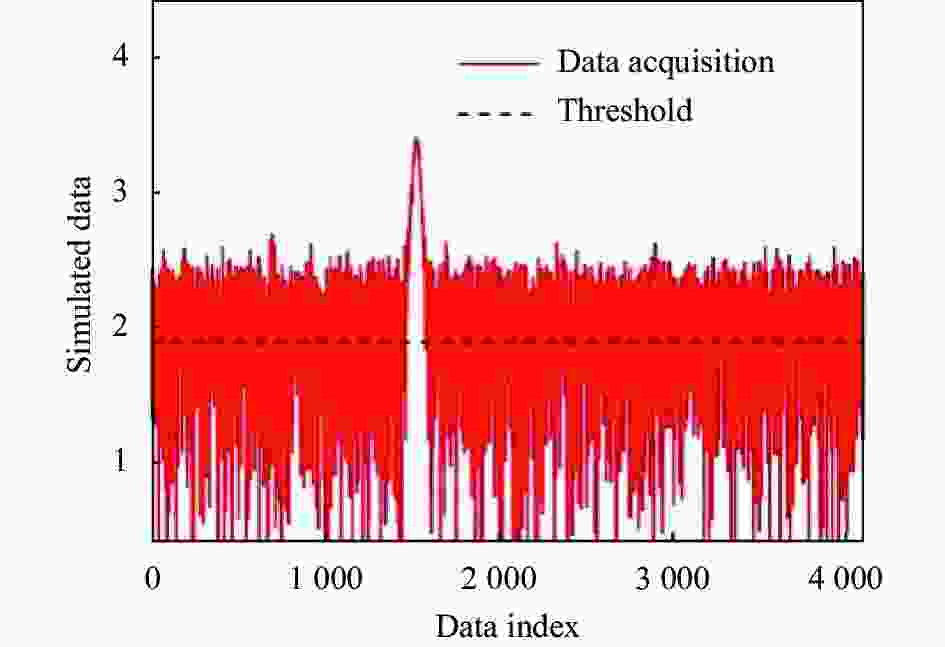
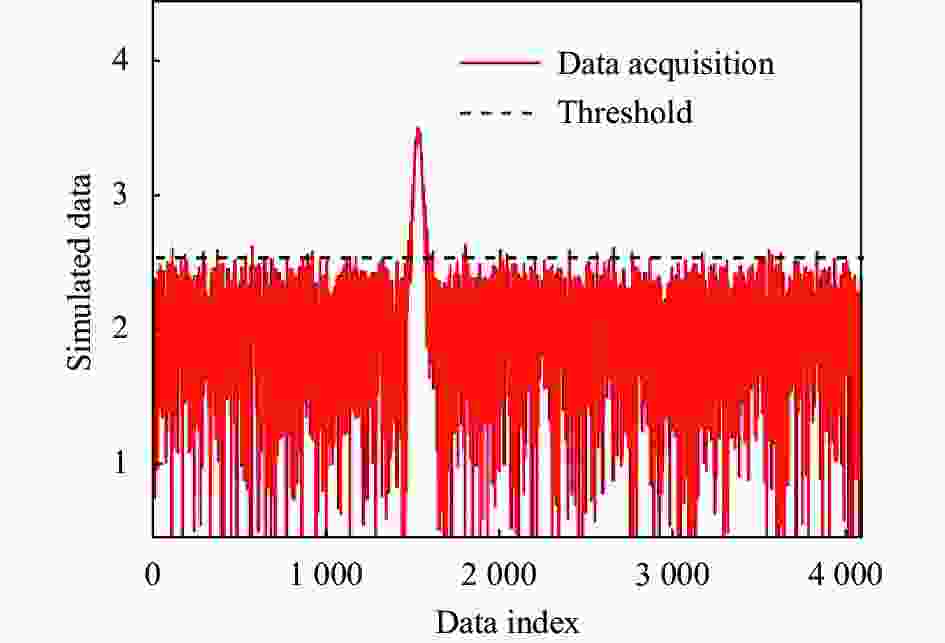
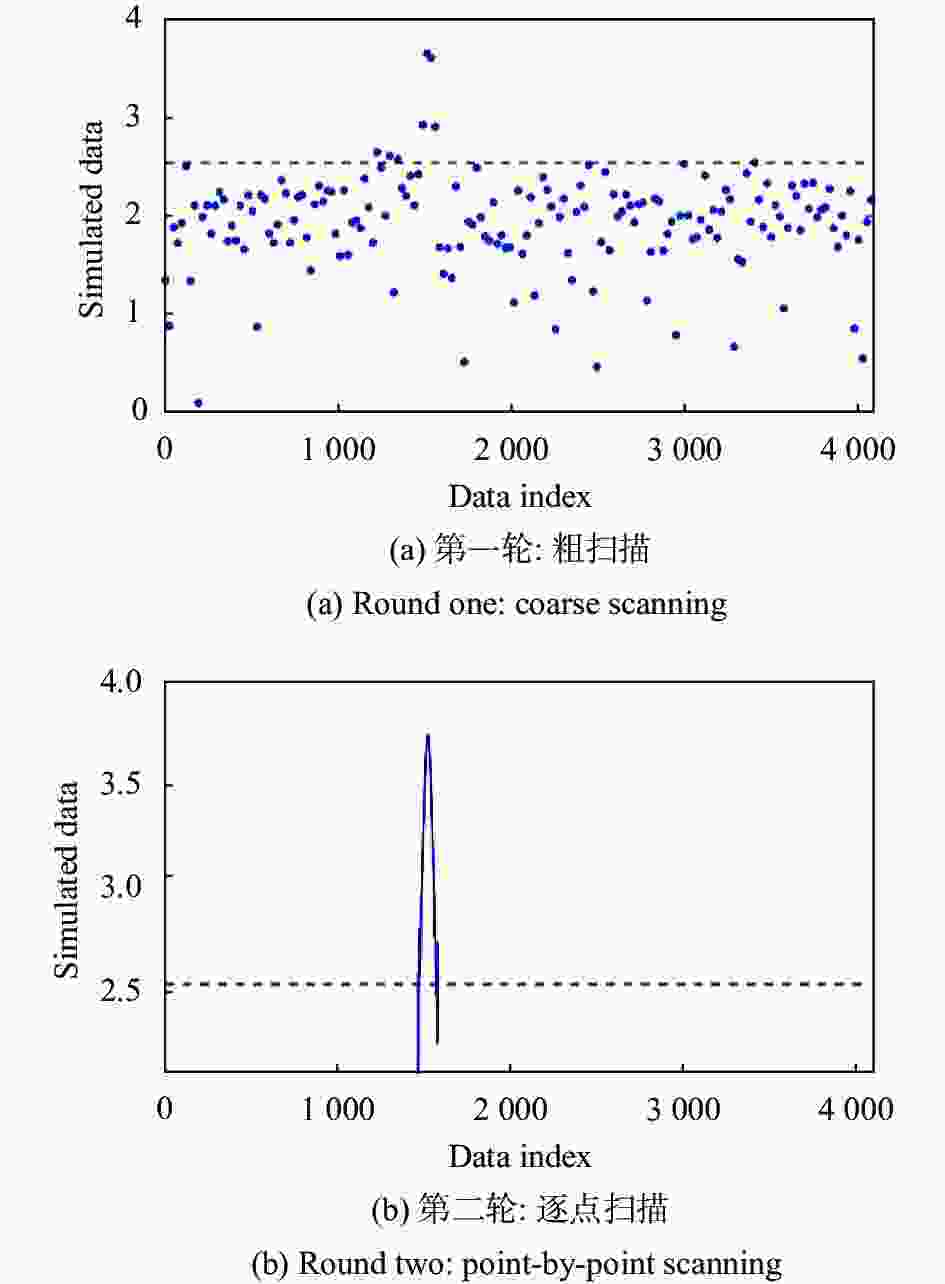

 DownLoad:
DownLoad:

